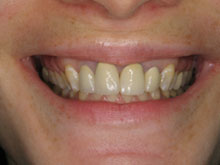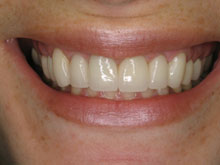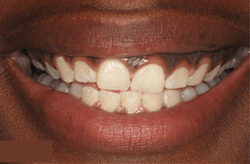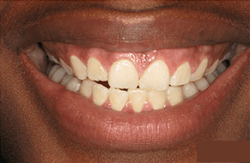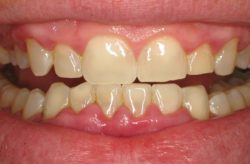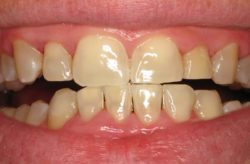Effects of Gum Disease
What is Gum Disease?
Gum or periodontal disease is a chronic gum disease that damages the soft tissue and underlying bone supporting the teeth. It can also cause a tooth to loosen or fall out. With time, the tissues that attach the gums to the teeth are destroyed by plaque and its toxins. The gums “pull away” from the teeth, and pockets begin to form between the teeth and gums. Plaque and calculus continue to fill these pockets until the jawbone supporting the teeth is eventually destroyed. This disease can progress to much more severe stages.
Causes of Gum Disease
Gum disease is a common but very preventable disease. It is caused by bacteria in dental plaque. If left untreated, the plaque buildup will eventually advance to periodontal disease. Here is how:
- When the sugars and starches from the food you eat interact with the bacteria, plaque begins to form on the teeth.
- If not removed, plaque can harden into tartar, also known as calculus. Calculus also originated from your saliva and will always return. Calculus sticks to your tooth and root surfaces and cannot be removed by brushing and flossing alone. Professional assistance is needed to remove it from your teeth.
- Chronic gum inflammation can cause periodontal disease. The inflamed gums create pockets where bacteria and plaque can harbor and manifest.
- Practicing good oral hygiene, such as brushing your teeth twice a day, flossing daily, and having regular dental checkups, can help your treatment and reduce your chance of developing periodontal disease.
Plaque is constantly forming on the teeth. Plaque irritates the gums, causing them to become red, tender, and swollen. If not removed daily, plaque turns into a hard material known as tartar or calculus. Calculus cannot be removed by brushing and flossing alone. A dentist, periodontist, or hygienist must remove it manually to stop the disease process.
Stages of Gum Disease
The stages of gum disease include:
- Gingivitis. This is the earliest stage of periodontal disease, where the gums are inflamed due to bacterial build-up along the gumline. The damage occurring at this stage can be reversed since the supporting bone and tissue have not been compromised.
- Periodontitis. During this stage of periodontal disease, the supporting bone and tissue are now irreversibly damaged. The bacteria has progressed below the gum line, and your gums may form pockets that trap food and plaque.
- Advanced Periodontitis. This is the most advanced and severe stage of periodontal disease. During this stage, the supporting bone and tissue are destroyed, which causes teeth to shift, drift, or eventually fall out.
Antibiotics can sometimes help; however, it is only a temporary solution. Regular periodontal maintenance check-ups and cleanings will always be needed to keep the bacteria from attacking your gums and teeth again.
What Are the Effects of Gum Disease?
Gum disease, also known as Periodontal disease, is an infection that damages the soft tissues and bone that supports the tooth or teeth. Failure to properly brush and floss away the harmful bacteria promotes growth. Eventually, the bacteria will begin to spread underneath the gum tissue and affect the underlying bone, which is known as advanced periodontitis.
If not correctly taken care of, gum disease can worsen and affect other parts and functions of the body. The disease has been linked to other health issues such as diabetes, stroke, heart disease, premature births, or low-birth-weight babies.
Gum Disease and Cardiovascular Disease
Gum and cardiovascular disease are major public health issues impacting many people daily. While these two diseases are in separate areas of the body, research indicates that periodontal disease and cardiovascular disease are connected; having one disease may increase your risk of developing the other.
The Link Between Gum Disease and Cardiovascular Disease
Both gum disease and cardiovascular disease involve chronic inflammation. Inflammation is the body’s instinctive reaction to fight off infection. Inflammation is initially good for your body but can lead to severe health complications. We, as periodontists, work with you to ensure healthy teeth and gums and manage your risk factors to prevent future disease progression. Maintaining gum health will help your heart stay healthy throughout your life.
Gum Disease and Respiratory Disease
Our immune system is a powerful, indispensable tool necessary to fight off infection. For a long time, scientists have known that smoking, the aging process, and other health problems that suppress or hinder the immune system place patients at risk for respiratory diseases like bronchitis, pneumonia, emphysema, and chronic obstructive pulmonary disease (COPD). Recent studies point to periodontal disease as an additional potential risk factor for developing these respiratory diseases.
How Gum Disease Affects Respiratory Health
Bacterial respiratory infections are thought to be acquired through aspiration (inhaling) of fine droplets from the mouth and throat into the lungs. These droplets contain germs that can breed and multiply within the lungs to cause damage. Recent research suggests that bacteria found in the throat and mouth can be drawn into the lower respiratory tract. This can cause infections or worsen existing lung conditions. People with respiratory diseases, such as chronic obstructive pulmonary disease, typically suffer from reduced protective systems, making it difficult to eliminate bacteria from the lungs.
Scientists have found that bacteria that grow in the oral cavity can be aspirated into the lung to cause respiratory diseases such as pneumonia, especially in people with periodontal disease. This discovery leads researchers to believe these respiratory bacteria can travel from the oral cavity into the lungs to cause infection.
Gum Disease and Diabetes
Individuals with diabetes are more likely to develop periodontal disease than those who do not have diabetes. Those with uncontrolled diabetes are at a higher risk of contracting severe infections in the mouth, such as periodontal or gum disease. The reason for this is that it is more difficult for the body of an individual with diabetes to defend itself from a bacterial infection.
How Do Gum Disease and Diabetes Correlate
Gum disease is a severe inflammation of the gums due to a bacterial infection in the mouth. The bacteria within the plaque buildup cause an infection of the gum and teeth. When left untreated, the infection can progress to an advanced stage. This advanced stage can cause tissue damage and, eventually, loss of teeth.
Research shows that the correlation between gum disease and diabetes goes both ways. If an individual has moderately advanced gum disease, controlling their blood sugar may be more challenging. This means that not only is the infection harder to fight due to diabetes, but diabetes is also harder to control when gum disease is present. Other factors that connect diabetes to gum disease include:
- Slowed circulation caused by diabetes can make the gum tissue more susceptible to infections.
- High glucose levels in the saliva promote increased bacteria production that causes gum disease.
- Diabetes reduces the body’s resistance to infections, increasing the gums’ risk of infection.
Gum Disease and Stroke
New research suggests that gum disease, or periodontitis, may increase the risk of stroke. Gum disease, also known as Periodontal disease, is an infection that damages the soft tissues and bone that supports the tooth or teeth. Poor brushing and flossing habits allow gum disease to develop along the gumline. Failure to properly brush and floss away the harmful bacteria promotes growth. Eventually, the bacteria will begin to spread underneath the gum tissue and affect the underlying bone, which is known as advanced periodontitis. Additionally, not attending regular dental visits can play an essential role in the development of gum disease.
A sticky film of bacteria (better known as plaque) forms and hardens on the teeth, denoting the beginning stages of gum disease. In more advanced stages of gum disease, the tartar formed can equate to sore and bleeding gums, discomfort while eating, tooth loss, and more.
Gum disease and periodontitis are treatable – and preventable – conditions. Treating gum disease in its early stages can be vital to preventing related complications – including stroke.
The Link Between Gum Disease and Stroke
Two recent studies suggest that treating gum disease decreases the risk of stroke by preventing artery blockage. Gum bacteria known as Streptococcus Sp DNA has been found in brain blood vessels. Gum disease was linked to strokes caused by a hardening of large arteries in the brain and severe artery blockages.
To put it simply, inflammation and infection are known to cause the blood to clot. If dental issues such as gum disease are left untreated, the infected buildup of tartar over time can result in a stroke. How? The buildup of bacteria, inflammation and prolonged unhealthy oral state can eventually narrow essential arteries.
Over 300 patients were examined within seven days after experiencing an acute ischemic stroke or transient ischemic attack. All participants underwent clinical and radiographic dental examinations. The team used the individual mean clinical attachment loss measured at four sites per tooth as the primary indicator for periodontitis.
After adjusting for age, sex, the number of teeth, and other factors, the risk of cerebral ischemia increased with the severity of periodontitis.
Subjects with severe periodontitis had a 4.3-fold increased risk of cerebral ischemia than those with mild or no periodontitis.
Active periodontal inflammation may contribute to a prothrombotic state via recurrent bacteremia, platelet activation, and elevated clotting factors, thereby increasing the risk of cardioembolism and cryptogenic stroke,’ say the authors.
Pinpointing Stroke Factors
These studies have concluded significant findings that link gum disease and stroke. These findings include:
- Gum disease was more common in patients with a stroke involving large blood vessels located in the back of the brain that control vision, coordination, and other critical bodily functions.
- Individuals with gingivitis were twice as likely to have moderately severe narrow brain arteries due to plaque buildup than those without gum disease.
- Researchers concluded that arteries in the brain were severely blocked (50 percent or more) in about 10 percent of those evaluated.
- After adjusting risk factors, they discovered that individuals with gingivitis were 2.4 times as likely to have severely blocked brain arteries.
It is essential for specialists to know that gum disease is a significant cause of inflammation for their patients and should educate them on the effects of gum disease.
Gum Disease and Cancer
Regularly taking care of your teeth and gums may not just save your smile; it could very well save your life. Detecting the difference between gingivitis, gum disease, and oral cancer can often be difficult. Research suggests an association between periodontal disease and certain types of cancer. This article will assist in differentiating between the three. In addition, it will give you all the necessary preventative steps to steer clear of oral cancer, beginning with the control of gingivitis before it gets to its progressive stages.
Gum Disease and Oral Cancer
Periodontal disease, or gum disease, is a progressive form of gingivitis that often leads to oral cancer when left untreated. Periodontal health and oral cancer both live within the oral cavity. They are directly linked when one’s periodontal health has been neglected or has progressed into some stage of oral cancer.
Oral cancer is currently the 6th most common cancer in the United States, and in the past 30 years, there have been no significant strides in improving treatments or survival rates of Oral Cancer cases. Why? Studies show that reliable early detection techniques are lacking. By the time most people with gum disease seek medical care, it has often advanced into the early or late stages of oral cancer.
Signs and Symptoms of Oral Cancer
Due to the lack of reliable early detection, it is of utmost importance for you to follow these three steps. Stay on top of your oral maintenance, get yourself familiar with the many symptoms of mouth cancers, and seek medical care if you experience any of the following suspicious signs or symptoms:
- Oral lump, lesion, or ulcer on the tongue, lip, or other areas of the mouth. These typically appear as a deep, hard-edged crack in the tissue. While they are usually pale in color, they may also appear dark or discolored.
- Mouth sores or a persistently abnormal/unusual taste in the mouth. These sores are often painless at first; however, they may develop a burning sensation or pain in their advanced stages
- Difficulty swallowing
- Unexplained tongue pain or issues
Risk Factors of Oral Cancer
Risk factors of oral cancer include:
- Tobacco use (including chewing tobacco or snuff) is associated with 70 – 80% of oral cancer cases
- Heavy alcohol use
- Poor oral hygiene and chronic irritation (such as from rough teeth, dentures, or fillings)
- Infection with HPV (human papillomavirus)
- Over 40 years of age
Gum Disease and Other Related Cancers
Other cancers related to the negligence of one’s oral health, mainly to the progression of Periodontal Disease, include but are not limited to the following:
- Lung Cancer
- Pancreatic Cancer
- Head and Neck Cancers
Oral Cancer Prevention
You should see your dentist regularly for a dental examination and preventive care. Many oral cancers can be discovered by routine dental examination. Any mouth sore that does not go away after two weeks is cause for concern and may be an early sign of mouth cancer. Other preventative tips include:
- Avoid alcohol use
- Practice good oral hygiene
- Minimize or avoid the act of smoking or use of tobacco
- Have any dental issues addressed and corrected immediately
Visit our Laser Periodontics & Gum Surgery professionals — one visit can save your life! Call (877) 440-3564 to schedule your appointment. We pride ourselves on being as thorough as possible so each and every patient maintains excellent oral health. If we are presented with a progressive case of Periodontal Disease (gum disease), our trained and qualified professionals will stop at nothing to provide the patient with an appropriate solution. Oral Cancer screenings are part of our daily routine here at Advanced Periodontics. Schedule your visit, and we will take care of the rest.
Gum Disease and Nutrition
There may be more reasons to watch what you eat other than maintaining a healthy weight. Studies indicate that obesity may be linked to periodontal disease. Obesity can result from an unbalanced diet, which may lack the nutrients known to help prevent gum disease. Also, excessive consumption of sugary drinks and foods is often associated with increased tooth decay and can have a negative impact on periodontal health. Without the proper nutrients from a healthy diet, the body can have difficulty fighting off infections such as periodontal diseases.
Diet and Gum Disease
Your diet is a crucial aspect of gum health that needs to be considered when preventing gum disease. Consuming increased amounts of sugar can increase your risk of developing tooth decay. Tooth decay occurs when the sugar in the oral cavity comes into contact with the plaque, which in turn causes the acid to attack the teeth, making it difficult for the tissues inside your mouth to resist infection. If the oral cavity is not properly maintained and the infection persists, this can contribute to the development of gum disease.
Foods to eat if you have Gum Disease
Proper nutrition benefits your overall health and is a key preventative against gum disease. It is essential to consume various foods with high nutritional value and provide added teeth-cleaning benefits. To promote a healthy oral cavity, foods to incorporate into your diet include whole grains, fruits and vegetables, calcium-rich foods, lean protein, and low-fat and dairy-free products.
Gum Disease and Women’s Health
Periodic fluctuations in hormone levels during the different stages of a woman’s life significantly affect their oral health and other body areas, including the gingiva (the gums). Recent studies have shown that 23% of women in the USA ages 30 to 54 have periodontal disease, and 44% of women ages 55 to 90 who still have their teeth also have periodontal disease. Periodontal disease is a silent, slowly progressive condition that may not have any gum disease symptoms (i.e., pain, loose teeth) until it is too late.
Gum Disease and Female Hormones: Puberty, Pregnancy, Menopause, and Post-Menopause Puberty
Gums and hormones directly correlate. Puberty in women is marked by an increase in sex hormones (progesterone, estrogen) which increase the blood flow to the gums, making them more sensitive to irritants like plaque or tartar. The gums may turn tender, red, and swollen, but these changes are usually temporary and diminish as a young woman ages.
Menstruation
Sometimes, women will notice bright red, swollen, bleeding gums and sores on the inside of the cheek just before their period. This menstruation gingivitis clears up once a woman’s period has begun.
Gum Disease and Pregnancy
Pregnancy also may bring specific gingival and periodontal changes for the expectant mother. During the second or third month of pregnancy, women may experience pregnancy gingivitis, a condition characterized by tender, swollen, bleeding gums. This condition, once present, may increase in severity through the eighth month of pregnancy and then begin to resolve. Women with infections such as periodontal disease are at risk for premature, low-birth-weight babies.
In some cases, gums already sensitive and swollen due to pregnancy gingivitis can react strongly to irritants and form large lumps called pregnancy tumors. These tumors are NOT cancerous and are generally painless. Persistent tumors may have to be removed by a periodontist. It is essential to consult with your dental professional to educate yourself on preventing gum disease during pregnancy.
Oral Contraceptives
Women who use oral contraceptives may experience similar symptoms of gum disease as pregnant women in the form of red, swollen, bleeding gums. Women taking oral contraceptives should be aware that medications sometimes used to treat periodontal disease (i.e., antibiotics) can decrease the efficacy of their contraceptive pill. Be sure to ask your dentist, periodontist, or pharmacist before taking any prescribed medication while on oral contraceptive therapy.
Menopause and Post-Menopause
Oral changes in menopausal or post-menopausal women may include dry mouth, pain, and burning sensations in the gums, cheeks, tongue, or altered taste. In addition, conditions where the gums peel off and leave a raw bleeding surface (termed desquamative gingivitis) are more prevalent in menopausal or post-menopausal women.
New research finds that bone loss is associated with periodontal disease and osteoporosis. Hormone replacement therapy (HRT) and proper nutrition that help fight osteoporosis may also protect the teeth.
What should you do?
- See your physician for yearly check-ups.
- See a dentist for cleanings twice a year.
- See a periodontist if you, your dentist, or your hygienist notice problems with your gum tissue.
- Tell your dentist, hygienist, or periodontist about your medications and any changes in your health history.
- Brush and floss daily.
- Use an ADA-approved fluoride toothpaste.
- Please contact us with any questions or request a free consultation.
Gum Disease and Bad Breath
Bad breath, or halitosis, can be caused by various factors. The most common cause of halitosis is caused by the bacteria that manifests in our mouths. The bacteria causes protein breakdown, which releases a foul odor known as bad breath. This bacteria manifests in several places in the mouth, such as on the teeth, the tongue, and inside pockets that form between the gums and teeth. If the bad breath is persistent, it may be a sign of gum disease.
How to Determine if I Have Bad Breath
Determining if you have bad breath or halitosis can take time and effort. However, some self-tests can help. These include:
- Take a dry, clean, unscented cloth and retract the tongue with one hand. Scrub the furthest part of your tongue for about 5 seconds. This should include approximately four good scrubs. Wait about 30 seconds and smell the cloth. If the cloth has a foul odor, it may signify the presence of halitosis.
- Take a piece of unwaxed, unscented floss and floss the upper or lower posterior teeth. Usually, 2 to 3 teeth should be sufficient to floss. Wait about 30 seconds and smell the floss. Again, if it has an odor, this may be a sign that the individual has halitosis.
- Lick the back part of your hand (not the palm side) for about 5 seconds. Wait 30 seconds. If you smell a foul odor, this too may indicate halitosis.
These are some simple techniques to determine the presence of bad breath. You may reduce the level of bad breath by thoroughly brushing your teeth, flossing, gently brushing your tongue, and regularly visiting the dentist. If this does not help, your dentist can recommend more advanced treatment options to help alleviate the problem.
Ways to Prevent and Control Bad Breath
To help keep your breath fresh and prevent bad breath, it is important to maintain a clean mouth and remove the lingering bacteria. Ways to prevent and control bad breath include:
- Brushing your teeth and gums properly twice a day with fluoride toothpaste.
- Brush your tongue using a tongue scraper to remove the lingering odor-causing bacteria.
- Floss between teeth to remove bacteria that forms between teeth and slightly below the gums. Brushing alone only removes 60% of the tooth’s surface. It is important to remove the bacteria in hard-to-reach areas by flossing.
- Use mouthwash that contains antibacterial agents that help kill odor-causing bacteria.
- Visit your dentist regularly for professional dental cleanings to remove bacteria the toothbrush cannot reach.
While a simple regimen of consistent brushing and flossing is an effective preventative method for bad breath, it does not treat the more severe symptoms such as gum disease. In this case, professional diagnosis and treatment can benefit from analyzing your particular cause of bad breath and helping with a possible solution.
Professional Treatment for Bad Breath
To prevent bad breath and decrease the risk of gum disease, it is crucial to practice good oral hygiene consistently. Depending on the specific cause of bad breath, further treatment may vary. If the cause of bad breath is related to oral health complications, our gum specialists will educate you on how to manage or control the condition properly.
Persistent bad breath is oftentimes a sign of gum disease. Depending on the severity of the gum disease, it can be treated with LANAP. LANAP is a minimally invasive, cutting-edge procedure involving the removal of bacteria and plaque buildup in hard-to-reach areas far below the gumline. It does not involve cutting or stitching, making the process virtually painless with quick healing time.
Schedule a complimentary consultation with our gum specialists if you want to learn more about LANAP and other treatment options!
Gum Disease and Oral Pathology
The inside of the mouth is usually lined with a particular type of skin (mucosa) that is smooth and coral-pink in color. Any alteration in this appearance could be a warning sign for a pathological process. (The most serious of these is oral cancer.)
Signs of Pathologic Process or Cancerous Growth
The following can be signs at the beginning of a pathologic process or cancerous growth:
- Reddish patches (erythroplasia)
- Whitish patches (leukoplakia) in the mouth
- A sore that fails to heal and bleeds easily
- A lump or thickening on the skin lining the inside of the mouth
- Chronic sore throat or hoarseness
- Difficulty in chewing or swallowing
Changes can be detected on the lips, cheeks, palate, and gum tissue around the teeth, tongue, face, and/or neck. Pain does not always occur with pathology and is not often associated with oral cancer. However, any patient with facial and/or oral pain without an apparent cause or reason may also be at risk for oral cancer. We recommend performing an oral cancer self-examination monthly and remembering that your mouth is one of your body’s most important warning systems. Do not ignore suspicious lumps or sores!
We perform an oral cancer examination on your first visit and as part of your regular six-month cleaning. Call us to schedule an appointment for a periodontal screening.
Periodontal Plaque
Research has shown that plaque must be controlled in order to combat periodontal or gum disease. Furthermore, by reducing plaque, dental decay can be kept to a minimum. Couple a lifetime of good plaque control with fluoride supplements (most effective when added to developing teeth during childhood), and dental decay becomes almost non-existent.
Plaque
Plaque is a transparent, sticky film that adheres to the surfaces of teeth, gum tissues, dental restorations, and even the tongue. It is so tacky that it can not be washed or rinsed off but must be mechanically removed. Plaque is neither food stuck on the teeth nor food debris. It contains a variety of bacteria that can cause dental decay, contribute to calculus (tartar) formation, and initiate the inflammatory response associated with periodontal disease.
How quickly does plaque form?
Unfortunately, plaque forms soon after it is removed. Some studies report that it starts forming as soon as five minutes after it is removed. Other reports state that it can take up to four hours. Effective plaque control will keep it to a minimum regardless of how quickly it begins reforming. That’s why we encourage brushing your teeth twice daily, plus daily flossing.
Plaque Removal
Periodic removal of plaque and calculus is the best way to control periodontal disease. At these times, the dentist/hygienist can examine the periodontal tissues to determine if new pockets have formed or previously diagnosed pockets have worsened. The frequency of these periodontal maintenance treatments is best determined by the dental professional treating you.
Can calculus form at different rates?
Definitely. Some people never form calculus, while others form it in varying amounts. Some individuals notice it days after a professional dental cleaning, while others hardly form any, even months later. The rate of calculus formation is not an indicator of the amount and severity of periodontal disease, nor does it indicate that an individual will ever get it. But its continued presence can always damage the gums.
Can calculus form under the gums?
Yes. There are two types of calculus. Supragingival calculus is the hard deposit on top of the teeth, the kind we can see and feel. Subgingival calculus forms below the gums. It is just as hard and adherent as supragingival calculus, but when present, it is a greater concern because it forms within the pockets. This allows the bacteria to congregate in greater numbers. Though removing plaque formed on top of/within subgingival calculus is difficult, it is necessary to do so because these pathogens cause more periodontal tissue breakdown.
Calculus (Tartar)
In some individuals, calculus forms despite the best oral hygiene. So what is it? Calculus is a hardened substance that comes from a combination of minerals in the saliva and dead plaque bacterial cells. Together, they precipitate a crusty deposit that, once mineralized, can grow rather quickly. When looked at under a microscope, calculus has all the nooks and crannies of a coral reef and a similar number of hiding places for bacteria to hide. Left on the teeth long enough, calculus begins to irritate the gums. The gums can swell, become ulcerated and bleed, and eventually get progressively worse, forming pockets.
Signs of Plaque
A frequent warning sign is when the edge of the gums next to the teeth become reddened and inflamed and bleed when touched. This early stage of gum disease is known as gingivitis and takes three weeks to form when all oral hygiene measures are suspended. Gingivitis is a reversible condition. With diligent flossing and toothbrushing, gingivitis usually disappears. Left untreated, it can progress into periodontal disease. Periodontal disease is defined as the formation of pockets (loss of gum attachment to the teeth) and the loss of bone that supports the teeth. Periodontal disease is a chronic disease that can result in tooth loss. In fact, periodontal disease is the main reason adults have teeth removed.
Are all plaques equal?
No. The rate plaque forms and what it’s made of varies from individual to individual. In fact, it varies in different parts of the same mouth. Studies have shown that plaque affects each of us differently; some are more susceptible to the bacterial components in the plaque than others. That’s why individuals have different healing responses to periodontal treatment.
Tips to Prevent Gum Disease
Although periodontal disease can cause serious oral health complications, the condition is preventable. Maintaining good oral hygiene and taking care of your gums is essential in preventing and treating periodontal disease. Following these helpful guidelines can help prevent and treat periodontal disease:
- Brush. Practicing good oral hygiene and brushing your teeth daily helps remove bacteria and food particles and massage the gums. Be sure to brush twice daily for a complete two minutes.
- Floss. Flossing is essential for removing food particles and bacteria trapped between the teeth and slightly below the gum line that a toothbrush cannot reach.
- Regular dental checkups. The dentist will examine the gums and other oral tissues during routine dental checkups for signs of periodontal disease. A professional dental cleaning will be performed that will remove the excess plaque and bacteria below the gumline.
FAQ
What is gum or periodontal disease?
Gum or periodontal disease is a chronic gum disease that damages the soft tissue and underlying bone supporting the teeth. It can also cause a tooth to loosen or fall out. With time, the tissues that attach the gums to the teeth are destroyed by plaque and its toxins.
How do I know if my gum disease is serious?
There are several different stages of gum disease, all with different signs and symptoms. The stages of gum disease include gingivitis, periodontitis, and advanced periodontitis. Symptoms to look out for worsening gum disease include:
- Inflamed or puffy gums
- Gums that bleed easily
- Gums that feel tender when touched
- Bright red swollen gums
Is gum disease reversible?
Gingivitis is the earliest stage of periodontal disease, where the gums are inflamed due to bacterial buildup along the gumline. The damage occurring at this stage can be reversed since the supporting bone and tissue have not been compromised.
Can gum disease cause cardiovascular disease?
Gum disease and cardiovascular disease are both major public health issues that impact many people every day. Both gum disease and cardiovascular disease involve chronic inflammation. Inflammation is the body’s instinctive reaction to fight off infection. Inflammation is initially good for your body because it helps heal. However, chronic (prolonged) inflammation can lead to severe health complications.
Can periodontal disease affect respiratory health?
Recent studies point to periodontal disease as an additional potential risk factor for developing these respiratory diseases. Bacterial respiratory infections are thought to be acquired through aspiration (inhaling) of fine droplets from the mouth and throat into the lungs. These droplets contain germs that can breed and multiply within the lungs to cause damage. This can cause infections or worsen existing lung conditions. People with respiratory diseases, such as chronic obstructive pulmonary disease, typically suffer from reduced protective systems, making it difficult to eliminate bacteria from the lungs.
How does diabetes affect your gum tissue?
Gum disease is a serious inflammation of the gums due to a bacterial infection in the mouth. Research shows that the correlation between gum disease and diabetes goes both ways. If an individual has moderately advanced gum disease, it may be more difficult to control their blood sugar. This means that not only is the infection harder to fight due to diabetes, but diabetes is also harder to control when gum disease is present.
What causes periodontal disease?
Periodontal disease is typically caused by the bacteria found in dental plaque. Plaque is the sticky substance that constantly forms on the surface of our teeth from the food and beverages we consume. When you do not practice proper oral hygiene, the bacteria will manifest and build up on your teeth. Several factors increase the risk of periodontal disease. The biggest risk factor for periodontal disease is smoking. The toxins and chemicals released into the mouth from smoking negatively affect the gums significantly.
How to treat periodontal disease?
One of our experienced periodontists can treat periodontal disease at any stage. Still, the treatment options depend greatly on the severity of the disease and the patient’s personal needs. Some gum disease treatment options include:
How Strong Is The Link Between Periodontitis And Stroke?
Recent studies have proven that there is a link between periodontitis and strokes. They found that individuals with gingivitis were twice as likely to have moderately severe narrow brain arteries due to plaque buildup compared to those with no gum disease. Gum disease is more common in patients with a stroke involving large blood vessels in the back of the brain that control vision, coordination, and other critical bodily functions.
What Serious Health Problem Can Gum Disease Lead To?
Gum disease, also known as Periodontal disease, is an infection that damages the soft tissues and bone that supports the tooth or teeth. Failure to properly brush and floss away the harmful bacteria promotes growth. Eventually, the bacteria will begin to spread underneath the gum tissue and affect the underlying bone, which is known as advanced periodontitis. Gum disease has been linked to other health issues such as diabetes, stroke, heart disease, premature births, or low-birth-weight babies.
What Are The Symptoms Of A Tooth Infection Spreading?
Common signs and symptoms for individuals to look out for if a tooth infection is spreading include:
- Swelling in the cheeks or face
- Persistent headache
- Nausea and vomiting
- High fever
- Severe pain in the tongue or mouth
How long before gingivitis turns into periodontitis?
The first symptom that generally appears during the early stages of gingivitis is gum inflammation. This symptom can occur in as little as five days. If left untreated, the symptoms will worsen, and the generalized symptoms will become more noticeable. This will eventually progress to periodontitis, where the gum tissue pulls back from the tooth’s surface, developing pockets, and allowing plaque to form under the gumline.
What Is Bad Breath?
Many cases of bad breath, or halitosis, are due to protein breakdown caused by the bacteria in the mouth. These odor-producing organisms can lurk anywhere: around the necks of the teeth, in pockets, next to fillings and crown margins, on the tongue, and in various other recesses in the mouth. Consider how prone the mouth is to grow these bacteria. It has all the ingredients of a successful incubator: it’s dark, moist, warm, and has all the “food” necessary that the bacteria need to metabolize. Left to their own devices, these odor-causing bacteria can thrive to the extent of causing bad breath.
What Can I Do To Overcome Bad Breath?
Practice good oral hygiene. This includes brushing and flossing regularly and effectively to remove the plaque as much as possible. If your mouth feels dry, drink plenty of liquids during the day. Use sugar-free mints or breath-freshening products found in health and drug stores.
What Else Can I Do To Help Keep My Breath Fresh?
Brush your tongue. Your dentist may recommend a special brush or tongue scraper, but a conventional, soft-bristled toothbrush will do just fine. Remember, bacterial plaque can hide in the filamentous recesses of the tongue, contributing to bad breath.
What Should I Do If Bad Breath Persists?
See your dentist. Make sure there are no prominent trouble spots contributing to this problem, especially an untreated periodontal condition like a gum abscess.
How Can I Treat My Bad Breath?
Persistent bad breath is oftentimes a sign of gum disease. Depending on the severity of the gum disease, it can be treated with LANAP. LANAP is a minimally invasive, cutting-edge procedure involving the removal of bacteria and plaque buildup in hard-to-reach areas far below the gumline. It does not involve cutting or stitching, making the procedure virtually painless with quick healing time.

